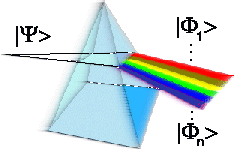Turkish Journal of Physics 23, 879 (1999)
Marian RUSEK, Arkadiusz ORŁOWSKI
Anderson localization of electromagnetic waves in random arrays of dielectric cylinders is studied. An effective theoretical approach based on the finite size scaling analysis of transmission is developed. The disordered dielectric medium is modeled by a system of randomly distributed 2D electric dipoles. The appearance of the band of localized waves emerging in the limit of an infinite medium is discovered. It suggests deeper insight into existing experimental and theoretical results.
Apr 5, 1999
Electromagnetic waves in disordered dielectric media: coupled-dipole model
Turkish Journal of Physics 23, 887 (1999)
Arkadiusz ORŁOWSKI and Marian RUSEK
An effective approach to multiple scattering of electromagnetic waves by disordered dielectric media is developed. A self-consistent energy-conserving coupled-dipole model is used. Applications to the Anderson localization of electromagnetic waves are presented. A complete set of Maxwell's equations is used to describe the propagation of waves and the vector character of the electromagnetic field is fully taken into account.
Arkadiusz ORŁOWSKI and Marian RUSEK
An effective approach to multiple scattering of electromagnetic waves by disordered dielectric media is developed. A self-consistent energy-conserving coupled-dipole model is used. Applications to the Anderson localization of electromagnetic waves are presented. A complete set of Maxwell's equations is used to describe the propagation of waves and the vector character of the electromagnetic field is fully taken into account.
Collective diffusion on hexagonal lattices - repulsive interactions
Surf. Sc. 441, 320 (1999)
ZAŁUSKA-KOTUR M. A. ; KRUKOWSKI S. ; TURSKI Ł. A.
Diffusion of interacting particle on a hexagonal lattice is studied by use of Monte Carlo simulations for a range of densities and temperatures including ordered and disordered phases. The decay of the initially prepared density perturbation is analyzed. Fast, local ordering happens at the beginning of system relaxation and clearly separates as a function of time the much slower global diffusion process. Locally equilibrated density perturbation decays according to the macroscopic diffusion equation, which allows a collective diffusion coefficient to be calculated. The density dependence of the collective diffusion coefficient is shown for several temperatures above and below the critical temperature.
ZAŁUSKA-KOTUR M. A. ; KRUKOWSKI S. ; TURSKI Ł. A.
Diffusion of interacting particle on a hexagonal lattice is studied by use of Monte Carlo simulations for a range of densities and temperatures including ordered and disordered phases. The decay of the initially prepared density perturbation is analyzed. Fast, local ordering happens at the beginning of system relaxation and clearly separates as a function of time the much slower global diffusion process. Locally equilibrated density perturbation decays according to the macroscopic diffusion equation, which allows a collective diffusion coefficient to be calculated. The density dependence of the collective diffusion coefficient is shown for several temperatures above and below the critical temperature.
Subscribe to:
Comments (Atom)
